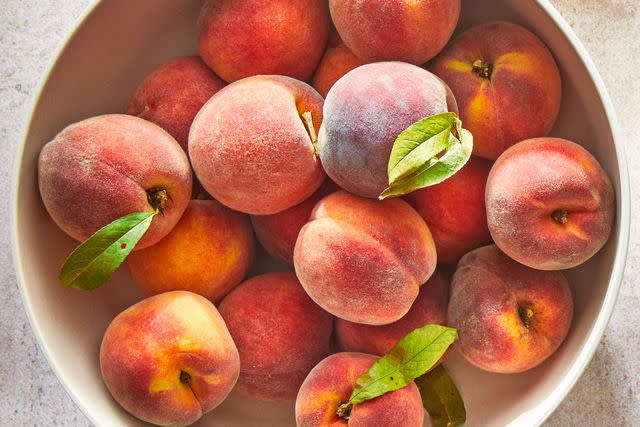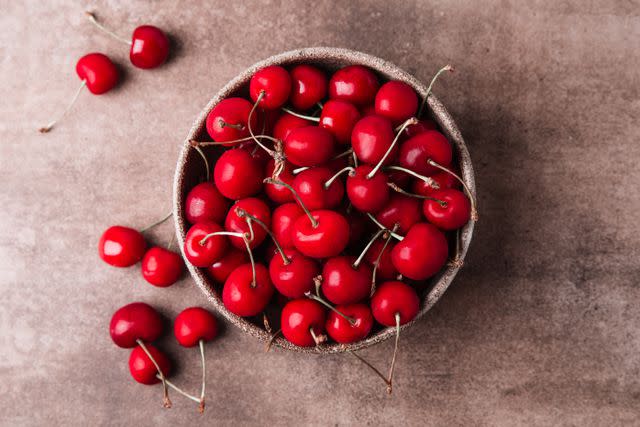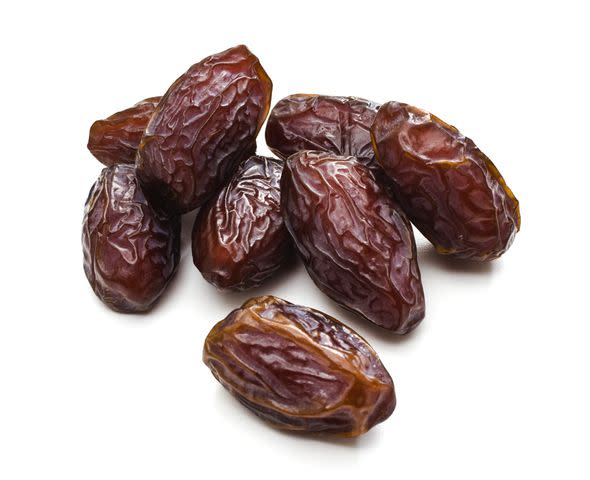What Is Stone Fruit? 13 Types To Cook With And Enjoy
As the weather warms and farmers markets are in full swing, mounds of plums, peaches, and cherries litter the tables and grocery store shelves ready for their Southern cobbler debut. We all know the stone fruit allstars, but some others make the list that may surprise even the savviest shopper.
What Is Stone Fruit
The basic requirement to be classified as a stone fruit is it must be a fruit with a pit (or stone) in the center. In the scientific world, they are known as drupes, and even within that classification, there are aggregates like raspberries that are clusters of individual drupes. They typically have thin skin, fleshy exteriors, and peak in summer.
Beyond the usual peaches, plums, and nectarines, there are hybrids that include tasty fruits like pluots and apriums. But even beyond that, flowering plants produce drupes like olives, coconuts, and dates.

Caitlin Bensel; Food Stylist: Torie Cox
Clingstone vs. Freestone Fruit
These terms usually come up when shopping for peaches. It refers to whether the pit (stone) “clings” to the flesh or is easily “freed” when the fruit is sliced open.
Clingstone peaches are delicious for eating but don’t hold up to freezing or canning. Freestone peaches on the other hand make delicious snacks as the fruit falls right off the stone, and they hold up well in canning and freezing.
How To Choose The Best Stone Fruit
The best test for ripeness is the scent. Bring the fruit to your face and breathe in the aroma. It should give off a delicate sweet smell. Also look for fruit that is soft, but not overly squishy. If you observe wrinkles near the stem, that’s a good sign of sweetness.
Stay away from fruit with bruising, dents, or off-colored spots. Aggregates pose a different issue because of their small delicate nature. Be on the lookout for mold as they are very susceptible to spoiling.
13 Common Types Of Stone Fruit
From the most popular (peaches and plums) to the not so obvious (olives and coconut), more than a dozen fruits that we love to enjoy, especially during peak summertime.
Peaches
The queen of stone fruit, peaches come in yellow and white varieties. They’re a favorite for pies and cobblers, but also are a great choice to add to summer cocktails, grill up for salads, and make into jam. Gobble them up May through late September.
Related: 60 Fresh Peach Recipes To Savor This Summer
Nectarines
Similar to peaches, nectarines are their smooth cousin. They also come in yellow and white varieties and lack the fuzzy skin on peaches. Their firm texture and tangy flavor make perfect foils for savory preparations like crostinis, and added to cherries make a delicious pandowdy.
Plums

The tart skin coupled with sweet flesh, make plums a satisfying snack. They come in red, yellow, and purple-black and really shine in jams and galettes (pie’s open-faced, rustic cousin). When plums are dried, they’re called prunes.
Related: Plum Recipes That Will Have Your Summer Table Dressed To Impress
Apricots
These diminutive pale orange treasures have fuzzy skins like a peach with bright orange interiors. They tend to be tart, but if dried turn into a sweet snack. They also make a wonderful choice for scone fruit or as a sauce base for savory preparations like Apricot Chicken.
Cherries

Early bloomers, cherries make their appearance in late spring to early summer. They come in a number of varieties, including six we profiled, and are one of the smallest stone fruits. Sour cherries (also known as tart cherries) have a lip-puckering taste that makes them less pleasant to eat raw, but delicious in baking preparations and jam. Queen Anne’s are the ones found in chocolate-covered cherries and the Shirley Temple’s best friend, maraschino cherries. Rainiers, Bing, and Black cherries are all plenty sweet enough to eat raw, but also make great additions to cakes, bars, and sauces, if you don’t mind pitting them.
Related: 34 Delicious Dessert Recipes To Make With Cherries
Mangoes
Way down South, the sultry heat helps this tropical fruit flourish. There are smaller versions like the Champagne and Honey mango, but the traditional fruit has a bright orange and red skin with bright orange flesh centered around a large pit. Their tangy sweetness pairs well with salty and spicy flavors found in salsas, ceviche, or blended in a cooling colada.
Lychees
This exotic fruit is grown all over Asia and South Africa and can often be found in specialty markets in the U.S. Once their coarse, red, inedible skin is removed, delicate white flesh is revealed that makes refreshing sorbet and is increasingly found in cocktails.
Olives
You may not have known olives were a fruit, but they are. Like other stone fruits, they have the typical central pit. Mostly associated with savory preparations, olives come in a wide variety of colors and flavors. Kalamatas fold into bread and Greek salads well. Cerignolas are large enough to stuff with favorite ingredients like blue cheese or feta. Mission olives, commonly known as black olives, are a coveted pizza ingredient. Manzanillas are the typical green olives you see with or without pimento stuffing. These briny bites also finish a dry martini and provide a tangy kick to muffuletta sandwiches.
Drupelets: Raspberries, Blackberries, And Mulberries

This family of stone fruit looks a little different than the typical peaches and plums—each aggregate has a “berry” containing a tiny pit. Raspberries can be enjoyed raw or make delicious jam, provide a tart foil for dark chocolate, and star as dessert ingredients. They come in red, black, and pale yellow. Blackberries tend to be a bit larger than raspberries and slightly sweeter. They work well in jams and jellies, added to yogurt or salads, or starring in an easy summer cobbler. Mulberries grow on trees rather than bushes like blackberries and raspberries. They come in red, white, and black varieties and are the smallest of the drupelets. Mulberries’ sweetness makes them tasty snacks fresh or dried and used in pastry preparations like scones.
Related: 30 Fresh And Delicious Blackberry Recipes
Coconuts
You might think they are nuts, but they are stone fruit. What we see in stores and at farmers markets are the pits of the fruit. The white flesh we use for coladas is the interior of that pit. Young coconuts (still green) can be tapped for water and are often seen on street carts in South Florida served with straws. Mature coconuts (the brown ones we see everywhere) need to be cracked open. Then the creamy milk can be used in cocktails, and the flesh can be dried and shredded for use in pies and cakes.
Dates

Another product of palm trees, dates are much smaller than coconuts. Usually found dried throughout the year, occasionally fresh dates show up in the fall. Once pitted, they make great additions to morning granola, quick breads, and scones.
Hybrids: Pluots, Plumcots, And Apriums
Hybrids bring the best of stone fruits together in one delicious creation. Each of these are hybrids of plums and apricots with varying ratios of each fruit. Plumcots are a 50-50 hybrid, apriums typically are 75% apricot, and 25% plum, while pluots flip that ratio and lean plum. They are specially bred and cultivated to marry traits like tartness and sweetness to produce a single fruit that performs well in tarts, jams, or just packed in a cooler for a lunchtime snack.
Almonds
Surprise! Almonds belong to the stone fruit family. The hard, green fruit grows on trees and when harvested and pried open, the seed (we know it as the common almond) is revealed. Belonging to the same family as peaches and nectarines may explain why almonds pair so well with other stone fruits, like in our Raspberry-Almond Muffins with Honey Butter.
For more Southern Living news, make sure to sign up for our newsletter!
Read the original article on Southern Living.

